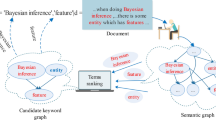Abstract
Aiming at the shortcomings of the TextRank method (TM) which only considers the co-occurrence between words and the incipient word importance when extracting keywords, this paper proposes a tolerance rough set (TRS)-based unsupervised keyword extraction method. Generally, how to score the words in a document has a significant influence on the word graph modeling. In this paper, we improve TM in two aspects with TRS theory that is used to mine vocabulary, semantics, grammar and other information in the corpus. First, the degree of words belonging to each document is calculated to form a fuzzy membership matrix, which helps to characterize the incipient word importance. Second, the fuzzy membership of words to each word tolerance class is calculated to form a semantic correlation matrix, which contributes to optimize the transition probability of all graph edges. We apply the proposed methods to the clustering tasks of two datasets, outperforming the strong baselines.





Similar content being viewed by others
References
Jaffry, S.W., Nasar, Z., Malik, M.K.: Textual keyword extraction and summarization: state of the art. Inf. Process. Manage. 56, 1–31 (2019)
Wang, Q., Ren, J.: Abstractive summarization with keyword and generated word attention. In: International Joint Conference on Neural Networks (IJCNN), Budapest, Hungary, pp. 1–8 (2014)
Li, T., Chen, Y.: Web page clustering based on searching keywords. In: International Conference on Intelligent Computation Technology and Automation(ICICTA), pp. 1163–1166 (2010)
Gu, Y., Shen, J.: Short text classification based on keywords extension. In: Chinese Automation Congress (CAC), pp. 2616–2621 (2019)
Mala, V., Lobiyal, D.K.: Semantic and keyword–based web techniques in information retrieval. In: International Conference on Computing, Communication and Automation (ICCCA), Greater Noida, India, pp. 23–26 (2016)
Mihalcea, R., Tarau, P.: Textrank: Bringing order into text. In: Proceedings of the Conference on Empirical Methods in Natural Language Processing (EMNLP), pp. 404–411 (2004)
Page, L., Brin, S., Motwani, R., Winograd, T.: The PageRank citation ranking: bringing order to the web. Stanford Digital Libraries Working Paper. (1998)
Skowron, A., Stepaniuk, J.: Tolerance approximation spaces. Fundam. Inf. 27(23), 245–253 (1996)
Qiu, D., Jiang, H., Yan, R.: Tolerance rough set-based bag-of-words model for document representation. Int. J. Comput. Intell. Syst. 1(13), 1–8 (2020)
Yan, R., Qiu, D., Jiang, H.: Sentence similarity calculation based on probabilistic tolerance rough sets. Math. Probl. Eng. 1, 1–9 (2021)
Witten, I.H., Paynter, G.W., Frank, E., Gutwin, C., Nevill–Manning, C.G.: KEA: Practical automatic keyphrase extraction. In: Proceedings of the Fourth ACM Conference on Digital Libraries (ACM), pp. 254–255 (1999)
Wu, Y.F.B., Li, Q., S, R., Chen, X.: Domain-specific keyphrase extraction. In: Proceedings of the 14th ACM Conference on Digital Libraries (ACM), Bremen, Germany, pp. 283–284 (2005)
Turney, P.D.: Learning to extract keyphrases from text. 1–45 (1999)
Wang, J., Song, F., Walia, K., Farber, J., Dara, R.: Using convolutional neural networks to extract keywords and keyphrases: a case study for foodborne illnesses. In: 18th IEEE International Conference on Machine Learning and Applications (ICMLA), Boca Raton, FL, USA, pp. 1398–1403 (2019)
Hung, B.T.: Vietnamese keyword extraction using hybrid deep learning methods. In: 2018 5th NAFOSTED Conference on Information and Computer Science (NICS), Ho Chi Minh City, Vietnam, pp. 412–417 (2018)
Blei, D.M., Ng, A.Y., Jordan, M.I.: Latent dirichlet allocation. J. Mach. Learn. Res. 3, 993–1022 (2003)
Bougouin, A., Boudin, F., Daille, B.: TopicRank: Graph-based topic ranking for keyphrase extraction. In: International Joint Conference on Natural Language Processing (IJCNLP), Nagoya, Japan, pp. 543–551 (2013)
Zhou, Q., Fang, Y., Shang, Z., Zhong, W.: Keyword extraction method for complex nodes based on textrank algorithm. In: International Conference on Computer Engineering and Application (ICCEA), Guangzhou, China, pp. 359–363 (2020)
Huang, Z.X., Xie, Z.P.: A patent keywords extraction method using TextRank model with prior public knowledge. Complex Intell. Syst. (2021). https://doi.org/10.1007/s40747-021-00343-8
Xiong, A., Liu, D.R., Tian, H.K., Liu, Z.Y., Yu, P., Kadoch, M.: News keyword extraction algorithm based on semantic clustering and word graph model. Tsinghua Sci. Technol. 26, 886–893 (2021)
Devlin, J., Chang, M.W., Lee, K., Toutanova, K.: Bert: Pre-training of deep bidirectional transformers for language understanding, pp. 1–16 (2018)
Tsatsaronis, G., Varlamis, I.: SemanticRank: Ranking keywords and sentences using semantic graphs. In: Proceedings of the 23rd International Conference on Computational Linguistics (ICCL), Beijing, China, pp. 1074–1082 (2010)
J, Martinez-Romo., L, Araujo, A.D, Fernandez: SemGraph: extracting keyphrases following a novel semantic graph-based approach. J. Assoc. Inf. Sci. Technol. 1(67), 71–82 (2016)
Duari, S., Bhatnagar, V.: SCAKE: semantic connectivity aware keyword extraction. Inf. Sci. 10, 100–117 (2018)
Bellaachia, A., Al-Dhelaan, M.: NE-rank: A novel graph-based keyphrase extraction in Twitter. In: IEEE/WIC/ACM International Conferences on Web Intelligence & Intelligent Agent Technology, pp. 372–379 (2012)
Florescu, C., Caragea, C.: PositionRank: An unsupervised approach to keyphrase extraction from scholarly documents. In: Proceedings of The 55th Annual Meeting of the Association for Computational Linguistics, pp. 1105–1115 (2017)
Biswas, S.K., Bordoloi, M., Shreya, J.: A graph-based keyword extraction model using collective node weight. Expert Syst. Appl. 12(97), 51–59 (2017)
Salton, G., Buckley, C.: Term-weighting approaches in automatic text retrieval. Inf. Process. Manage. 24(5), 513–523 (1988)
Pawlak, Z.: Rough sets. Int. J. Comput. Inf. Sci. 11, 341–356 (1982)
Kawasaki, S., Binh, N., Tu, B.: Hierarchical document clustering based on tolerance rough set model. In: European Conference on Principles of Data Mining and Knowledge Discovery (PDMKD), Springer, Berlin, Heidelberg, pp. 458–463 (2000)
Mao, X., Huang, S., Li, R., Shen, L.: Automatic keywords extraction based on co-occurrence and semantic relationships between words. IEEE Access. 8, 117528–117538 (2020)
Acknowledgements
This work was supported by the National Natural Science Foundations of China (Grant No. 12171065 and 11671001).
Author information
Authors and Affiliations
Corresponding author
Rights and permissions
About this article
Cite this article
Qiu, D., Zheng, Q. Improving TextRank Algorithm for Automatic Keyword Extraction with Tolerance Rough Set. Int. J. Fuzzy Syst. 24, 1332–1342 (2022). https://doi.org/10.1007/s40815-021-01190-y
Received:
Revised:
Accepted:
Published:
Issue Date:
DOI: https://doi.org/10.1007/s40815-021-01190-y




